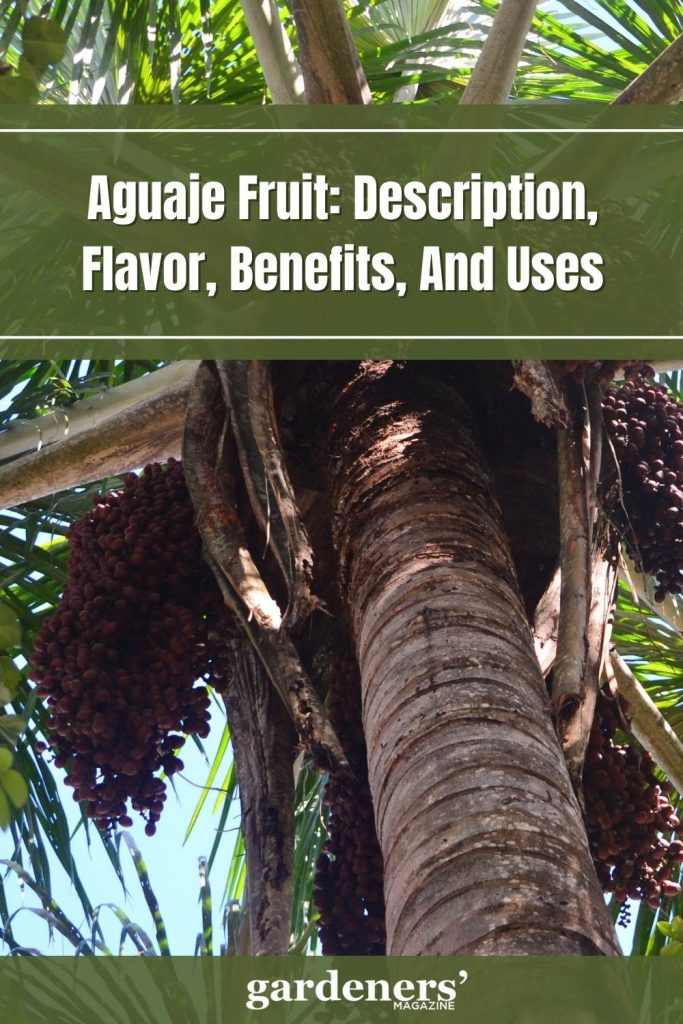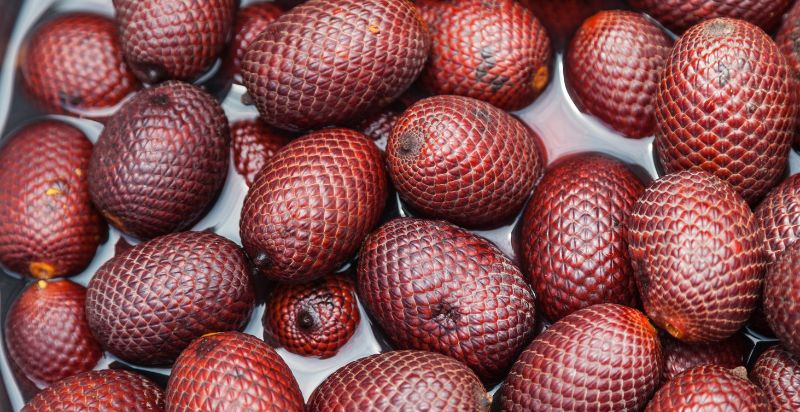Aguaje fruit, or Moriche Palm Fruit or Buriti, is a tropical fruit native to South America. The indigenous people of the Amazon have consumed it for generations, and it is now becoming increasingly popular for its many health benefits.
Aguaje fruit is packed with vitamins, minerals, antioxidants, and essential fatty acids that can help improve overall health. This article will examine what makes this amazing superfood so beneficial and how you can incorporate it into your diet.
What is Aguaje Fruit?
Aguaje fruit is a tropical fruit that comes from the moriche palm tree. It grows in Ecuador, Peru, and other parts of South America. The fruit looks like a yellow-orange oval with a thin skin and small seeds. When ripe, it has a sweet and creamy flavor that can be enjoyed fresh or cooked.

History and Origin of the Aguaje Fruit:
The aguaje fruit originates from the Amazon rainforest, which grows abundantly. It is native to Northern Peru and parts of Ecuador, Colombia, Bolivia, and Brazil. This small orange-yellowish fruit has been part of the Peruvian diet for centuries. The Incan civilization even venerated this superfood as sacred and used it in ceremonies and rituals.
In recent years, aguaje has become increasingly popular in the international community due to its medicinal properties and distinctive flavor. Its popularity is largely derived from its natural source of antioxidants, carotenoids, and polyphenols essential for our health and well-being.
Today, you can easily find aguaje in many forms, including frozen pulp, powder, or oil if you live outside Peru or Ecuador. However, try to go for organic products as much as possible since pesticides are widely used to cultivate this fruit. Enjoy its sweet taste in smoothies, juices, or directly from the fruit.
Health Benefits of the Aguaje Fruit:
One of the most notable health benefits of aguaje is its high content of Vitamin A. Vitamin A helps maintain healthy eyesight, reduce the risk of macular degeneration and other eye diseases, and even slow down the aging process.
Aguaje also contains significant amounts of dietary fiber that can aid digestion, prevent constipation, and help manage glucose levels. Additionally, aguaje is rich in magnesium which can help reduce stress levels, improve nerve function and muscle contraction, and contribute to bone health.
The anti-inflammatory properties of aguaje can also help improve the health of your cardiovascular system. Studies have shown it can reduce high blood pressure, cholesterol levels, and triglycerides. Additionally, its antioxidant content helps fight off free radicals and protect against oxidative stress, which can lead to cancer.
Where are Aguaje Fruit Grown and Harvested?
Aguaje fruit is native to the Amazon rainforest and is cultivated on a large scale in Peru, Colombia, Ecuador, Bolivia, Brazil, and Venezuela. The aguaje palm tree begins producing fruits in its fifth year of growth and reaches full maturity after 10-15 years.
The wild aguaje trees are harvested from March to August each year while the cultivated ones can be harvested all year round. The harvesting involves climbing the trees and cutting down the ripe clusters of fruits with a machete or a curved knife. After harvesting, the fruits are sorted into different sizes, determining their market price.
Flavor Profile of the Aguaje Fruit:
The aguaje fruit has a sweet and slightly sour taste, with hints of tropical flavors like pineapple and coconut. The flesh is soft and creamy, similar to a ripe mango or peach. When cut open, it has a pleasant scent, making it an enjoyable snack or addition to desserts and salads.
Where to find the Best Quality Aguaje Fruit?
The best quality aguaje fruit can be found in Bolivia and Peru, where it is grown naturally. In some countries, such as the United States and Mexico, aguaje fruit is available online. It is also found in specialty health food stores and Latin American markets. The fruit can also be purchased from vendors in tropical regions such as Florida and Hawaii. Additionally, aguaje fruit can often be found at Latin American farmers’ markets.
When purchasing aguaje fruit, look for specimens that are firm to the touch with a bright yellow coloration on the outside of the skin. Avoid purchasing soft fruits or those with brown spots or discoloration, as they may not have been stored properly or are overripe. As aguaje fruit is a seasonal product, it may be difficult to find the best quality in certain parts of the world; however, with some research and patience, high-quality fruits can usually be found.
How to Store Aguaje Fruit?
Aguaje fruit can be stored in the refrigerator for a few days. To preserve it longer, cut it into smaller pieces and freeze it. Alternatively, you can dry the it in an oven at a low temperature until dry. Once dried, the pieces should be cooled and stored in airtight containers or bags in a cool, dark area or the freezer for up to six months.
It is also possible to juice or puree the aguaje fruit and store it in ice trays so that you have frozen cubes of aguaje available to add flavor to smoothies and other recipes. Make sure to label each container with its contents and date of storage so that you can easily identify and use it later. Aguaje fruit can also be canned or pickled for long-term storage. Enjoy this delicious Amazonian fruit in many different ways.
You can also turn aguaje into syrup, jam, or jelly to spread over toast, oatmeal, pancakes, and more. The bright yellow coloring of the syrup makes it perfect for adding an exotic flair to your breakfast. When incorporating aguaje into recipes or eating it alone, remember that its taste is similar to mango and peach combined.
Feel free to add other sweet fruits like bananas, strawberries, or pineapple when blending smoothies with frozen cubes of aguaje. For added sweetness, try adding some honey or sugar after tasting the mixture. Enjoy the sweet and exotic flavor of aguaje.
How to Use Aguaje Fruit in Recipes?
Aguaje fruit can be enjoyed in a variety of ways. It is often eaten fresh or added to salads, smoothies, and juices for a tropical flavor. The creamy texture and sweetness make it perfect for adding to desserts such as ice cream, mousse, custards, pies, or other baked goods. It can also be used to make sauces and savory dishes like ceviche. Aguaje can also be dried and ground into flour used in baking recipes or as a thickening agent in soups and stews. No matter how you incorporate it into your recipes, aguaje will surely add an exotic touch guaranteed to please.

Conclusion
Aguaje fruit is a delicious, tropical treat that can be enjoyed in many ways. Whether eaten fresh, frozen, dried, or blended into recipes, this sweet Amazonian fruit will bring a unique flavor and texture to any dish. The best quality aguaje fruit can be found in Bolivia and Peru as well as online and at specialty stores and markets worldwide. With some research, this delicious fruit can be found and enjoyed in any corner of the globe.
From its powerful health benefits to its versatility in recipes, aguaje is an incredible superfood that should not be overlooked. So go ahead and give it a try – you won’t be disappointed! Enjoy the sweet, exotic flavor of aguaje fruit today.
- Everything You Wanted to Know About Red Tamarillos - June 2, 2025
- A Guide to Tulips: Everything You Need to Know & More… - June 2, 2025
- Guanabana: Description, Flavor, Benefits, And Uses - May 27, 2025

1 thought on “Aguaje Fruit: Description, Flavor, Benefits, And Uses”
Comments are closed.